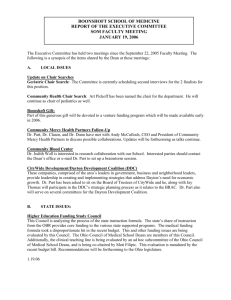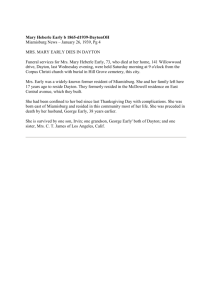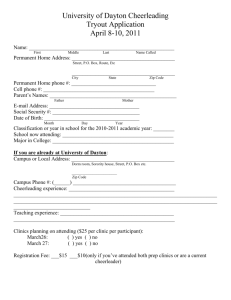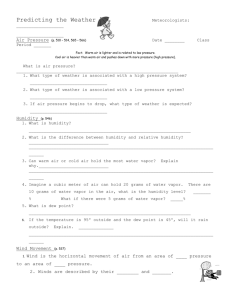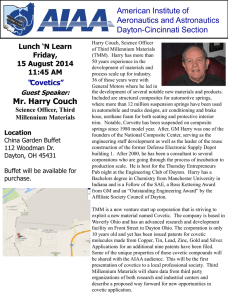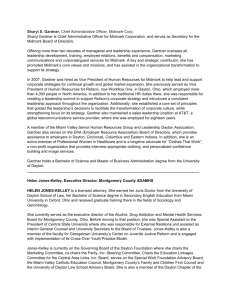Nibco and the Westview Industrial Park: A Dayton Original Case Study
advertisement
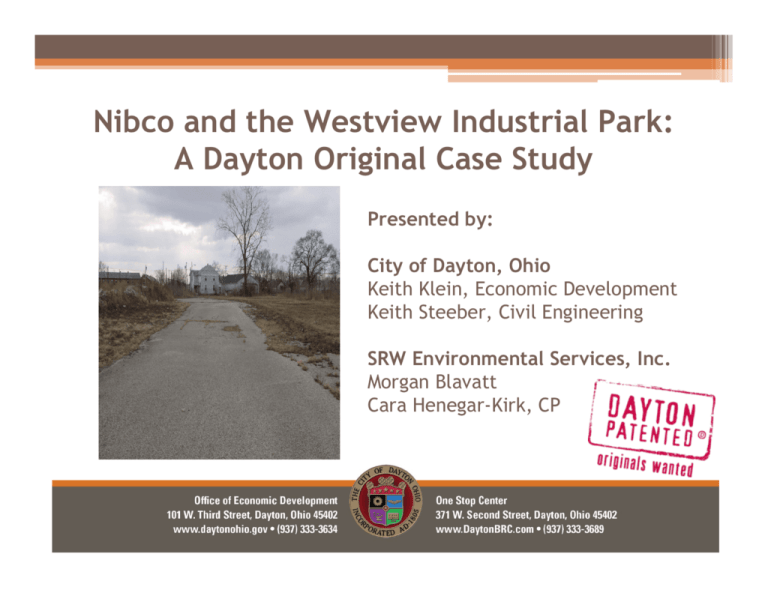
Nibco and the Westview Industrial Park: A Dayton Original Case Study Presented by: City of Dayton, Ohio Keith Klein, Economic Development Keith Steeber, Civil Engineering SRW Environmental Services, Inc. Morgan Blavatt Cara Henegar-Kirk, CP Part I: Development in Dayton Providing the Context Dayton’s Industrial Past: City of a Thousand Factories Dayton’s First Transition: Great Flood of 1913 More than 360 people died. Nearly 65,000 people displaced. 20,000 homes were destroyed. Property damage over $100 million (equal to $2.2 Billion today). • Resulted in Levee system used today. • • • • Life in Dayton Today: By the Numbers People: • City Population 152,000 • Regional Pop. 1.2 Million • 42,000 downtown workers • 40,000 downtown students • 25,000 WPAFB workers • Largest single-site employer • 7 million annual visitors Transportation: • I-70/75 interchange: • 154,000 vehicles a day • Dayton International Airport • State Route 4 and U.S. 35 • Active Rail Lines Dayton’s Oregon District Dayton’s New Transition: Changing Perceptions • # 1 mid-size region for new businesses 2009 and 2010. • Site Selection Magazine • # 6 school for young entrepreneurs – University of Dayton. • Entrepreneur Magazine • #16 in exports as a percentage of gross metro product. • Brookings Institution • #20 city for new college graduates starting careers. • BusinessWeek Magazine Dayton’s Bright Future: New Vision for a New Century • Greater Downtown Plan • Ohio Aerospace Hub • Wright-Patterson AFB • Tech Town Project • Growing Anchor Institutions ▫ Hospitals & Universities • New Amenities & Parks • New Business Incentives Asset-Based Strategy: Places & Space • Brownfield Development and infrastructure investments are two important parts of a multi-layer strategy to make Dayton more attractive to businesses in Ohio. • This case study will show an example of how cities can leverage both. : Infrastructure Projects: Building Bridges • Multi-year rebuilding project ▫ Stewart Street Bridge (near UD) ▫ Edwin C. Moses Blvd. Bridge ▫ Washington Street Bridge • Enhanced lighting and design Infrastructure Projects: Paving the Way • Street improvements ▫ Downtown ▫ Philadelphia Avenue Good Samaritan Hospital ▫ Stewart Street University of Dayton ▫ West Third Street Wright-Dunbar Historic District ▫ Valley Street Children’s Medical Center Dayton’s Bright Future: Brownfield Redevelopment is Key • Create job ready sites • Update City’s image • Revitalize neighborhoods • Eliminate slum and blight • Rebuild core of region • Modernize industry • Attract new investment • Help local companies grow Part II: Building Capacity Brownfields in Dayton A Learning Experience: Dayton Tire & Rubber (1990) 1980’s - Public nuisance, community outcry. 1990 – Property was demolished. Several partial, incomplete remediation actions in response to public demands. Today – Vacant land with no highway access and limited redevelopment potential. Land is abandoned and encumbered with liens. A Success Story: 5/3 Field Baseball Stadium (1999-2000) • Former GM site • City purchased for redevelopment plan • Removed 800 c.y. of petroleum contaminated soil • $26 million project with Public-Private Partnership • 2011 expected to be 12th straight sell-out season Tech Town North GH&R Project (2002-2003): Dayton’s First Clean Ohio Site Tech Town North Project Today: A Thriving Industrial Site n n n n City, County, State, Federal Contributions Demolition, Remediation, Infrastructure, TIF Committed end user revitalized the property New construction & subsequent additions yield jobs The Changing Face of Dayton: UD Acquires Former NCR Properties 2005: University of Dayton (UD) acquired former NCR brownfields. 2010: UD Research Institute (UDRI) acquires NCR Headquarters for $18M Clean Ohio and Job Ready Sites grants The Changing Face of Dayton: GE Aviation Announces $51M “EPISCENTER” November 22, 2010: GE Aviation announces new research facility on the former NCR property. First major win for Dayton’s Aerospace Hub! Construction begins this summer at UD on the former NCR site with occupancy beginning in 2012. Dayton’s Flagship Project: Tech Town Back then… • 30-acre GM plant • Over 1,000,000 SF of obsolete structures • Soil and groundwater contamination • Once over 5,000 employees • Closed in 80’s, sold in ’96. • Highly visible blight on downtown at the time. Not-Quite Tech Town: Prior to Demolition (2005) Tech Town Demolition: Final Phase, 2009 Tech Town Master Plan: Tech Town Vision: • Create technology-based office campus. • Construct 200-400,000 s.f. of office/commercial space. • Establish connections with Downtown, UD, RiverScape Park and Tech Town North Campus across the river. Tech Town Building A: Creative Technology Accelerator (CTA) • 42,000 S.F. Leased. • LEED Gold Certification. • Ribbon Cutting was held on August 30, 2009. • Tenants include the world’s only RFID tech incubator. Tech Town Building G: Smart Office Project • 63,000 SF for lease • Ohio Job Ready Site • New Market Tax Credits (NMTC) • Now under construction • Opening this summer. Tech Town & Webster Station: Expanding the Scope • “ESI Building” in Webster Station • Former GM Wastewater Plant ▫ Near Tech Town • 2010 Clean Ohio Grant • Work underway, nearly complete. Dayton’s Newest Clean Ohio Project: Former Howard Paper Site • Vacant paper factory on the riverfront near Downtown and Sinclair Community College. • 4.5 acre site. • Led by out-of-state developer • $1.1 Million Clean Ohio Grant. • Demolition to begin in Spring. Part III: Westview Industrial Park A Dayton Original Case Study Westview Planning Study: Area Analysis Downtown • 1999 CitiPlan 20/20 • 1999 Planning Study by McKenna & Associates • The study identified key areas of future redevelopment potential. • West of Downtown and I-75. • Adjacent to U.S. 35 • Univ. of Dayton Arena Westview Planning Study: Site Conditions (1999) North: Highway, Railroad, & mixed uses East/West: Mix of residential & commercial South: Dayton Metropolitan Housing Authority Northwest: Former Delphi plant Westview Industrial Park: The seed of an idea • Study ranked identified areas of redevelopment potential. • Top priority: Former McCalls Plant & Nibco Foundry. • Early conceptual site plan shown here. (Too many sites?) Westview Industrial Park: Key Features • 55 acres on 2 sites • Highway access via Route 35 at James H. McGee Boulevard exit • 90 seconds by car to I-75 and Downtown Dayton • Rail access on site • Marketable building • 348,000 s.f. Westview Industrial Park: McCall Press Demo (2000) • Community nuisance in the middle of the Westview area • Reuse plan adopted by City • Good development potential -35 acre site -Adjacent to highway -Infrastructure in place • Structure Remediated and demolished McCall Press Site Today: Lessons Learned • Tax foreclosure is a tool for property acquisition. • A redevelopment plan builds public support and justifies public investment. • A plan is not enough: resources are needed for implementation. • Redevelopment can be a very slow process in disadvantaged areas, when competing with greenfield suburban sites. Westview Industrial Park: Former Nibco Foundry Nibco site circa 2000 Former Nibco Foundry: Site History Kuhn’s Brothers Foundry was Established 1888 Company acquired by Nibco 1982 Purchased by investor in 1988 Closed in 1989 Foreclosed in 1995 Donated to City in 2002 Former Nibco Foundry: Structural Demolition (2004-2005) • City-funded demolition project • Nuisance Abatement Program (CDBG) • Asbestos tiles, shingles, etc. Former Nibco Foundry: Phase II Assessment (2005) After demolition… Clean Ohio Assistance Fund (COAF) Grant $288,000 awarded in September, 2004 SRW Environmental selected as contractor and Certified Professional Former Nibco Foundry: Phase II Assessment Results (2005) Samples Borings Contaminants Cost Former Nibco Foundry: Additional Sampling(2007) Groundwater issue required further delineation of site boundary for future Clean Ohio grant application Former Nibco Foundry: Clean Ohio, Again (2008) Clean Ohio Revitalization Fund $896,048 awarded December 17, 2008 Demolition and remediation project PACE Former Nibco Foundry: Public Works Process Demolition specifications established by City of Dayton Division of Civil Engineering. Remediation specifications created by SRW Environmental, Inc. Demolition bid process carried out by the City’s Department of Public Works Invoicing managed through Department of Public Works Business Office. Former Nibco Foundry: New Infrastructure Match James H. McGee Boulevard Extension Construction in Summer, 2011 Cost of $1.4 million Former Nibco Foundry: New Infrastructure Match Former Nibco Foundry: Demolition Project Kick-Off (2009) Nibco: Work Begins Nibco: Digging In Nibco: Making progress Nibco: Open Trenches Nibco: Crushing Concrete Nibco: USTs Found Nibco: Pumping out USTs Nibco: Asbestos Pipe Wrap Nibco: Hydraulic Lifts Nibco: Contaminated Soils Nibco: Groundwater Issues Former Nibco Foundry: Remediation Results (2010) 150 cubic yards of PCB Impacted concrete removed 6,090 cubic yards of impacted soil excavated 7,425 tons of non-haz soil removed and disposed $210,000 to remove unexpected Asbestos $544,000 total cost to remediate asbestos, soil, and impacted concrete Former Nibco Foundry: Demolition Results (2010) 174,000 cubic yards of asphalt pavement removed 6,500 cubic yards of slabs and foundations removed 12,450 cubic yards backfilled $505,000 to demolish 9 months to complete Former Nibco Foundry: Pitfalls and Challenges Costs exceeded expectations More soil removal than expected Previously unknown buried asbestos Winter weather slowed progress Communication between multiple parties sometimes difficult. Remediation required multiple rounds of sampling and testing. Former Nibco Foundry: Keys to Success Long-range planning Communication with team Partnerships with State and Private sector Contingency plans Celebration! Note: City was able to tap into rental income from McCall industrial building to pay for cost overruns. Former Nibco Foundry: Key Project Partners • City of Dayton • Office of Economic Development (project manager) • Department of Public Works (Div. of Civil Engineering) • Department of Water (Div. of Environmental Management) • State of Ohio • Ohio Department of Development (ODOD) • Ohio Environmental Protection Agency (OEPA) • Regional Air Pollution Control Agency (RAPCA) • Private Sector: • SRW Environmental, Inc. (environmental consulting) • Charles H. Jergens, Inc. (demolition/remediation) Westview Industrial Park: Next Steps Complete NFA / CNS Construct roadway Marketing existing building Marketing land for sale Additional acquisitions More groundwater samples for possible USD Re-plat property Facilitate Development! Conclusion: When it comes to brownfields, patience is a virtue! Thank you! Questions? Nibco and the Westview Industrial Park: A Dayton Original Case Study Presented by: City of Dayton, Ohio Keith Klein, Economic Development Keith Steeber, Civil Engineering SRW Environmental Services, Inc. Morgan Blavatt Cara Henegar-Kirk, CP
